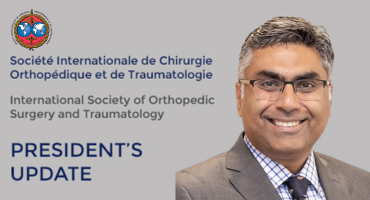Editorial
Unhappy patient - when will the pendulum stop swinging
 Anant Mahapatra
Anant Mahapatra
I was recently asked by a colleague to review a gentleman at one year following a total knee replacement. I was satisfied with his post-operative history, physical examination and radiological findings. I concluded that he did not need any further orthopaedic intervention.
The patient did not agree. He had multiple complaints and felt that there was more that could be done for him. This is a common phenomenon leading to the phrase “I have pain, but the doctor says my X-ray is normal” or “The X-ray looks good but feels bad.” In such cases it is important to treat the patient and not the X-ray. Symptoms of pain and discomfort should always be taken seriously due to the potential for psychosocial problems and disruption of normal life. There should be careful evaluation and exploration of the patient’s concerns and often empathy, reassurance and time are all that is needed.
However, during my assessment of this particular gentleman, I found him to be quite an unhappy person. His history revealed dissatisfaction with almost all areas of his life: work, family, social life, interpersonal relationships and his knee. He had gone through many negative experiences during his upbringing and throughout his adult life. This had evidently coloured his outlook and responses to mental and physical stressors.
Understanding patients’ experiences and expectations by medical professionals is an important part of our training. During my earlier years, the culture of medicine involved a more paternal doctor-patient relationship with doctors being seen as the pinnacle of excellence and were rarely questioned. Now in my consultant years, I have seen the pendulum swing towards the opposite direction. Patients are far more involved in their own care, capacity and consent are critical for doctors to understand, information regarding any topic is at a patient’s fingertips and patients have more choice. Doctors are being seen as fallible and are placed under greater scrutiny by our own governing bodies and the media. As such, patients tend to expect and demand more.
This is the widely recognised shift from medical paternalism to patient autonomy. Overall this has caused an improvement in the quality of care and treatment that patients are afforded. However, neither extreme of the pendulum is optimal. Doctors are consulted for a reason. Years of training, wide-ranging experience and specialised skill means that their opinion should be an important driver of clinical decisions. The patient is not a customer and may not always be right.
In the end, communication is the key. Burgener in Health Care Manager Volume 36 (2017) found communication to be the root cause of conflict in the medical setting. He emphasised the AIDET framework of “acknowledge, introduce, duration, explain and thank”, to enhance communication among patients, families and medical staff. This has served to assuage patient and family anxiety and distrust, reduce conflict and improve safety outcomes and patient satisfaction.
Despite all this, there is a small cohort of patients with a negative paradigm who will always remain unhappy. Bringing such patients to satisfaction after a procedure would be very difficult even if the best clinical outcomes were achieved. Sometimes poor outcomes after surgery are expected and in certain high-risk patients this is not negligence or incompetence but the reality of limitations in modern healthcare.
An important point of effective communication is to provide patients with enough information to make fully informed and appropriate clinical decisions about their health. Burgener also highlighted factors such as patient age and severity of diagnosis which may increase the likelihood of a patient taking a less active role in the decision-making process. Perhaps the patient’s unique personality should also be considered. I wonder how much information should be discussed with patients who are showing signs of being difficult and how much weight should be placed on the concerns they raise. Autonomous values of capacity and consent are of utmost importance, and the patient always has the final decision. But, to what degree should doctors bow to a patient’s request if they feel a procedure or intervention is unwarranted and possibly even harmful? This issue is further complicated by differences in public and private healthcare models around the world. How much does this dynamic change pending on who is paying for our time?
As the years pass on we do really see that the bar of patient satisfaction is slowly getting higher and higher and that patients may not have realistic goal posts with regards to treatment. I think we are at a crossroads where we must stop the swinging of the pendulum from one end to the other and develop a balanced view of what doctors can provide and what patients should expect in our healthcare services.















